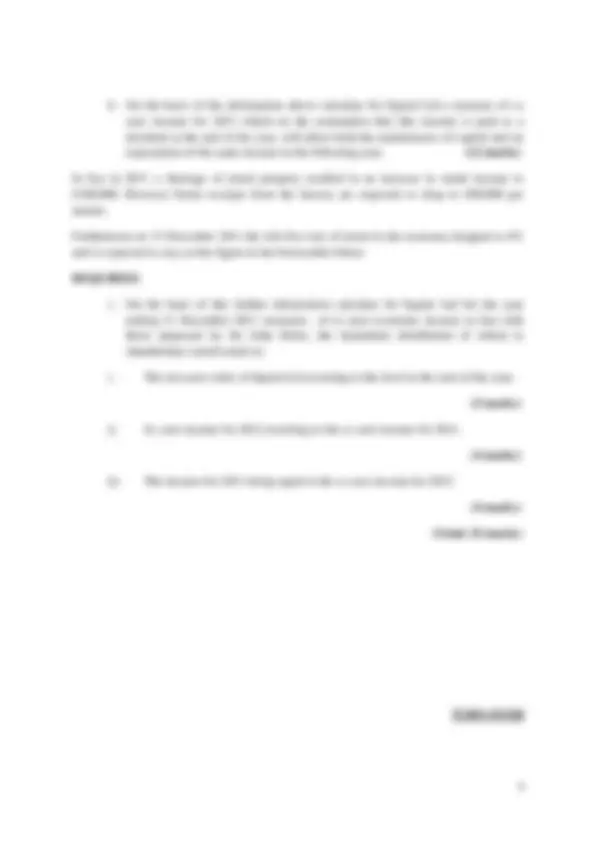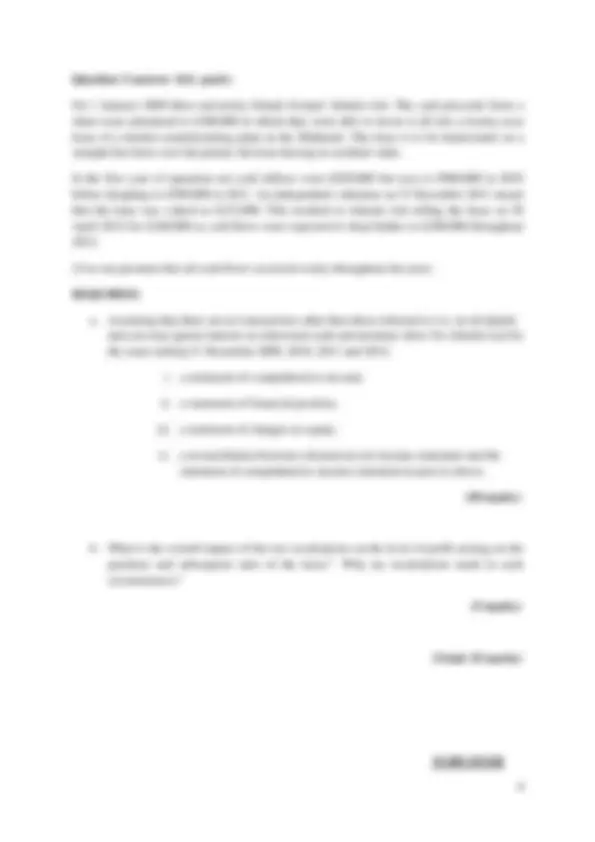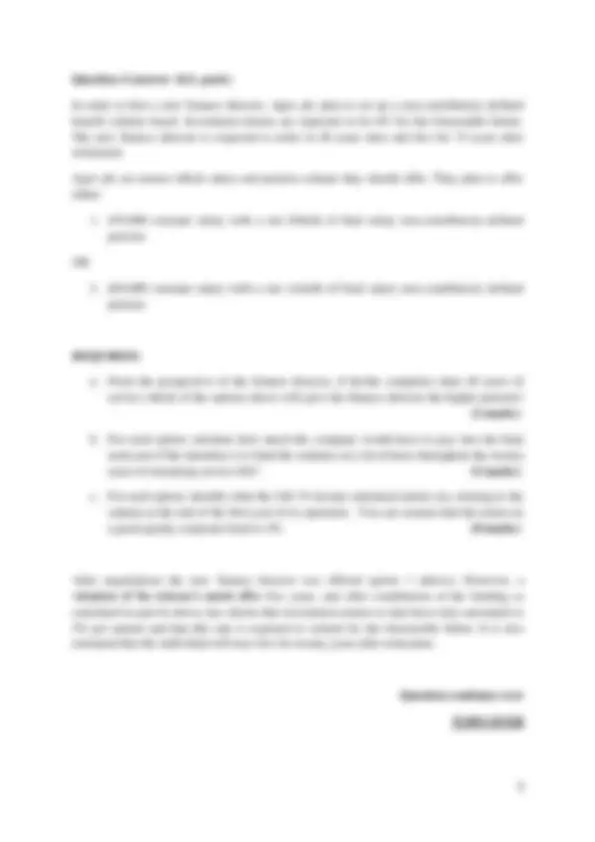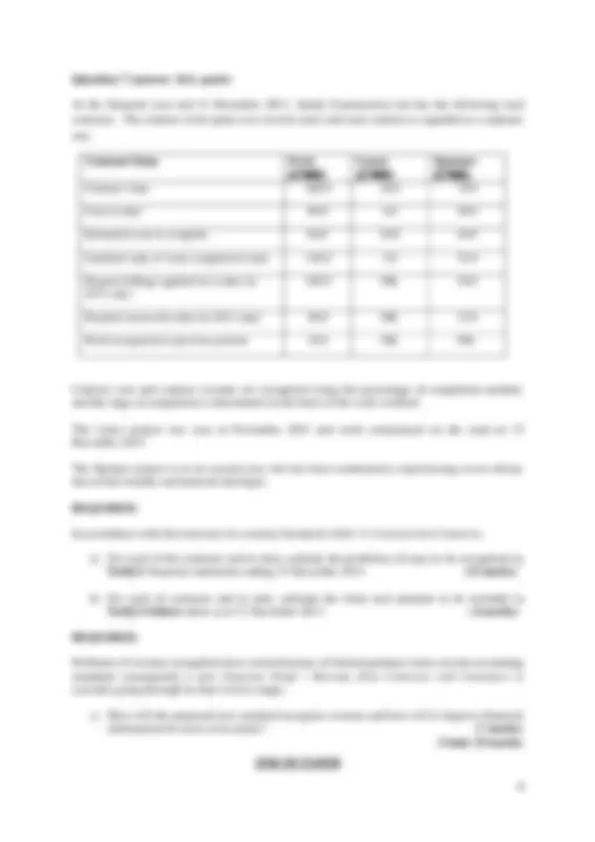






Study with the several resources on Docsity

Earn points by helping other students or get them with a premium plan


Prepare for your exams
Study with the several resources on Docsity

Earn points to download
Earn points by helping other students or get them with a premium plan
Community
Ask the community for help and clear up your study doubts
Discover the best universities in your country according to Docsity users
Free resources
Download our free guides on studying techniques, anxiety management strategies, and thesis advice from Docsity tutors
Rationales, Accounting Concept, Government Bond, Nominal Value, Bank Deposit, Overall Risk Free Rate, Rental Income, Ordinary Share Capital, Maintenance of Capital, Immediate Distribution. Given points represent accounting and finance exam paper.
Typology: Exams
1 / 8

This page cannot be seen from the preview
Don't miss anything!





ARHOLIADAU EXAMINATIONS Mai / Mehefin 2012 May / June 2012
Total marks available – 100
You should explain any assumptions you need to make.
Show all workings clearly
You will be provided with: Mathematical, Statistical and Financial Tables for the Social Sciences by Kmietowicz and Yannoulis
Casio FX83ES/GT or FX85ES/GT calculators only may be used.
Question 1 (answer ALL parts)
a. Explain FASB’s fundamental rationales for wanting to create a generally accepted conceptual framework. (10 marks)
b. Explain why attempts to create a generally accepted framework have not been made sooner and why successive attempts have led to controversy. (10 marks)
c. Using an example, identify clearly the difference between an accounting convention and an accounting concept (5 marks)
(Total: 25 marks)
Question 2 (answer ALL parts)
Squint Ltd is a company which holds financial and other securities. As at 1 January 2011 it holds the following assets:
An irredeemable government bond paying 3% per annum on a nominal value of £200,
£45,000 bank deposit. Interest payable on this deposit is variable and moves in accordance with the overall risk free rate in the economy
Property which is expected to generate rental income of £60,000 per annum into the foreseeable future
Squint Ltd is financed by £750,000 ordinary share capital and a £615,000 loan on which interest is payable at 7% per annum. This loan is repayable on 31 December 2014.
The risk free rate of return in the economy is 5% and it is expected to stay at this rate for the foreseeable future. You may assume that Squint Ltd is able to borrow and invest any remaining cash at the applicable risk free rate of return.
You may also assume that all cash flows occur on the last day of the year to which they relate and that there is no taxation in the economy.
REQUIRED:
a. Construct for Squint Ltd a summarised opening balance sheet as at 1 January 2011, in accordance with conventional accounting principles, clearly stating your assumptions. (4 marks)
Question continues over
TURN OVER
Question 3 (answer ALL parts)
On 1 January 2009 three university friends formed Atlantis Ltd. The cash proceeds from a share issue amounted to £300,000 in which they were able to invest it all into a twenty year lease of a derelict manufacturing plant in the Midlands. The lease is to be depreciated on a straight line basis over the period, the lease having no residual value.
In the first year of operation net cash inflows were £650,000 but rose to £900,000 in 2010 before dropping to £500,000 in 2011. An independent valuation on 31 December 2011 meant that the lease was valued at £215,000. This resulted in Atlantis Ltd selling the lease on 30 April 2012 for £240,000 as cash flows were expected to drop further to £300,000 throughout
(You can presume that all cash flows occurred evenly throughout the year).
REQUIRED:
a. Assuming that there are no transactions other than those referred to (i.e. no dividends and you may ignore interest on reinvested cash and taxation) show for Atlantis Ltd for the years ending 31 December 2009, 2010, 2011 and 2012:
i. a statement of comprehensive income;
ii. a statement of financial position;
iii. a statement of changes in equity;
iv. a reconciliation between a historical cost income statement and the statement of comprehensive income statement in part (i) above.
(20 marks)
b. What is the overall impact of the two revaluations on the level of profit arising on the purchase and subsequent sales of the lease? Why are revaluations made in such circumstances?
(5 marks)
(Total: 25 marks)
Question 4 (answer ALL parts)
In order to hire a new finance director, Apex plc plan to set up a non-contributory defined benefit scheme based. Investment returns are expected to be 6% for the foreseeable future. The new finance director is expected to retire in 20 years time and live for 15 years after retirement.
Apex plc are unsure which salary and pension scheme they should offer. They plan to offer either:
OR
a. From the perspective of the finance director, if he/she completes their 20 years of service which of the options above will give the finance director the higher pension? (2 marks)
b. For each option calculate how much the company would have to pay into the fund each year if the intention is to fund the schemes on a level basis throughout the twenty years of remaining service life? (5 marks)
c. For each option, identify what the IAS 19 income statement entries are, relating to the scheme at the end of the first year of its operation. You can assume that the return on a good quality corporate bond is 4%. (8 marks)
After negotiations the new finance director was offered option 1 (above). However, a valuation of the scheme’s assets after five years, and after contribution of the funding as calculated in part b) above, has shown that investment returns to date have only amounted to 5% per annum and that this rate is expected to remain for the foreseeable future. It is also estimated that the individual will now live for twenty years after retirement.
Question continues over
TURN OVER
Question 6 (answer ALL parts)
HotAir plc is involved in developing and manufacturing a new hot air balloon which can be powered on solar energy only. Development and testing is now reaching the final stages with a successful test flight in August 2011 and it is intended to manufacture and sell these balloons in August 2012. HotAir’s financial year end is December 2011 and the following costs have been incurred:
i. To make the industry aware of the new balloon a two strand marketing campaign was undertaken - the first campaign starting in August 2011 and the second in March 2012. A price of £300,000 has been agreed for the whole campaign with two equal payments to be made in September 2011 and April 2012. ii. Professor Sunning was employed on 1 October 2011 on an annual salary of £36,000 to research the effects of the sun on heavy industrial plastic. iii. Further costs of £200,000 were incurred regarding the development of the balloon in Quarter 4 of 2011. iv. After the initial marketing campaign four orders have already been received. To manufacture and test these balloons, a further two employees were employed at a cost of £24,000 on 1 September 2011. v. To cope with the new production HotAir plc increased their factory space – costing £480,000. This new space was used from 1 July 2011 and buildings are depreciated on a straight-line basis over 20 years. REQUIRED:
a) Explain how the activities above should be reflected in HotAir plc’s financial statements for the year ending 31 December 2011. You should clearly justify your choice of accounting treatment and state all assumptions you make. (10 marks)
On 1 January 2012, Company X acquired Company Y for £300,000. The fair value of Company Y’s net assets is £200,000, and Company X has considered capitalising the brand element of Company Y’s main product at an estimated valuation of £50,000.
b) Using the figures above how much goodwill could be recognised? (2 marks) c) If the brand was to be recognised as an intangible asset how would your answer differ to that in part (b) above? (5 marks)
d) Goodwill and intangible assets are accounted for differently. Explain why these assets are different and in what circumstances an organisation is able to recognise an intangible asset. (8 marks)
(Total: 25 marks)
TURN OVER
Question 7 (answer ALL parts)
At the financial year end 31 December 2011, Sandy Construction Ltd has the following road contracts. The contract work spans over several years and each contract is regarded as a separate one.
Contract Data Fork (£’000)
Lance (£’000)
Spanner (£’000) Contract value 2 00.0 36.0 7 0. Costs to date 8 0.0 4 .0 50. Estimated costs to complete 6 0.0 20 .0 4 6. Certified value of work completed to date 12 0.0 3.0 35. Progress billings applied for to date (in 2011 only)
100 .0 NIL 20.
Payment received to date (in 2011 only) 8 0.0 NIL 15. Profit recognized in previous periods 20.0 NIL NIL
Contract cost and contract revenue are recognised using the percentage of completion method, and the stage of completion is determined on the basis of the work certified.
The Lance project was won in November 2011 and work commenced on the road on 15 December 2011.
The Spanner project is in its second year, but has been continuously experiencing severe delays due to bad weather and material shortages.
REQUIRED:
In accordance with International Accounting Standards (IAS) 11 Construction Contracts ,
a) For each of the contracts and in total, estimate the profit/loss (if any) to be recognized in Sandy’s financial statements ending 31 December 2011. (12 marks)
b) For each of contracts and in total, estimate the items and amounts to be included in Sandy’s balance sheet as at 31 December 2011. ( 6 marks)
REQUIRED:
Problems of revenue recognition have arisen because of limited guidance from current accounting standards consequently a new Exposure Draft – Revenue from Contracts with Customers is currently going through its final review stages.
c) How will the proposed new standard recognise revenue and how will it improve financial information for users of accounts? (7 marks) (Total: 25 marks) END OF PAPER